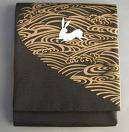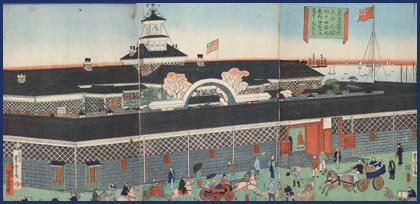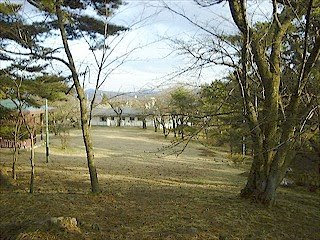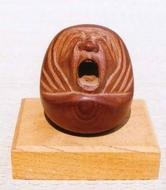[ . BACK to DARUMA MUSEUM TOP . ]
:::::::::::::::::::::::::::::::::::::::::::::::::::::::::::::::::::::::::::::::::::::::::::::::::::::
Fudo Myo-O Gallery
:::::::::::::::::::::::::::::::::::::::::::::::::::::::::::::::::::::::::::::::::::::::::::::::::::::
Memyo Bosatsu 馬鳴菩薩(めみょうぼさつ)
Mamyoo, Meimyoo 馬明(鳴)(マミョウ・メイミョウ)菩薩
"Neighing Horse Bosatsu"
梵命(アシュウバアグホーシャ)
Sanskrit : Ashvagosha
Memyou Bosatsu
This deity, sometimes seen as a female incarnation, is closely related to the silk industry of Japan and China. For the connection between the horse and the silkworm, see below. His statues were often found in areas raising silkworms. Some are simple stone reliefs, some were rather elaborate. Silk farmers would conduct the annual festivals in his honour.
 © PHOTO : kawamura
© PHOTO : kawamura
Memyou Bosatsu is mostly shown sitting on a horse, with six, four or two arms. He holds various things in his hands, for example scales and thread or a reel. These things are essentials for the silk production. He is also sourrounded by attendants, sometimes of Chinese form and robes.
There was also a poet in India of the name Ashvagosha (Asvaghosa) in the second century, who first opposed Buddhism but later became a devote practitioner.
:::::::::::::::::::::::::::::::::::::::::::::::::::::::::::::::::::::::::::::::::::::::::::::::::::
At the roadside, Shiobara, Gunma prefecture
群馬県大間々町塩原の穴原薬師堂にある馬鳴菩薩
 © PHOTO : mori chan
© PHOTO : mori chan
:::::::::::::::::::::::::::::::::::::::::::::::::::::::::::::::::::::::::::::::::::::::::::::::::::
At temple Chokoku-Ji (Chookokuji) 菩提山長谷寺
This temple dates back to Gyoki Bosatsu about 1270.
 © PHOTO : bear7
© PHOTO : bear7
:::::::::::::::::::::::::::::::::::::::::::::::::::::::::::::::::::::::::::::::::::::::::::::::::::
Other versions of this deity
"Neighing horse deity", menari myojin 馬鳴明神
"Silkworm God", kaikogami, sanjin 蚕神 , カイコガミ
"White Deity", O-Shirasama, oshirasama おしらさま、オシラサマ
"White Buddha", O-Shira butsu オシラ仏, おしら仏
Okonai sama オコナイサマ / Okunai sama オクナイサマ
Kokage Myoojin 蚕影(こかげ)明神
Kodama sama 蚕玉様. 蚕養神
Memyoo Kannon, Memyoo Benten, Memyoo Yakushi
馬鳴菩薩・観音・弁天・薬師
Komagata Myojin 駒形明神
Tobigami 飛神 "flying god"

see 棟方志功 Munakata Shiko :
source : 飛神の柵 Tobigami no saku
.................................................................................
 Oshirasama amulets in a temple, Iwate
Oshirasama amulets in a temple, Iwate
 Oshirasama amulet from Hanamaki, Iwate
Oshirasama amulet from Hanamaki, Iwate
o-shirasama ningyoo おしらさま人形 Oshirasama figure
It helps with eye diseases and for diseases of women. It protects children.
. Amulets and Talismans from Japan .
.................................................................................
O-Shirasama ー short for O-Shirase sama お知らせ様
Deity which makes an announcement. オシラセサマ
When the hunters of Tono could not decide where to go, they followed the path their horse would lead them - oshirase お知らせ.
Later this deity would also make an announcement before an earthquake, fire or other calamity.
「オシンメ様」「オシンメイ様」(福島県
オシラガミ、オシラホトケ、カノキジンジョウ(桑の木人形)
.......................................................................
Okunaisama オクナイサマ - 家の神 Deity in the Home
Statues are placed in the
Tokonoma alcove of the best room.

Okunai-sama is the Kami of a household which is carved from mulberry wood with a simple face drawn on it. A piece of cloth with a hole in it is put over this to act as a piece of clothing. In one story the Okunai-sama comes into the fields as a short boy and helps to plant the rice fields before a storm comes. No one realizes the helpful boy is Okuanai-sama until they return home and find that the statue is covered in mud from the fields.
In another story the farmer's wife works in the fields when the rain starts. Coming home she finds the washing, which was hanging outside, now safely inside the entrance and the Okunai-sama has a wet robe.
People never eat meat in front of the statue.
source :morefolkbeliefs.html
. Toono monogatari 遠野物語 Tono Monogatari
Legends of Tono - Iwate - Tōno monogatari .
:::::::::::::::::::::::::::::::::::::::::::::::::::::::::::::::::::::::::::::::::::::::::::::::::::::::
蚕神, Kaiko sama as stone memorial
 © PHOTO : sachix
O-Kaiko Sama
© PHOTO : sachix
O-Kaiko Sama is especially popular in Northern Japan and the Kanto area around Tokyo. Its origin goes back to a farmer's wife in Nagano prefecture, Shimo-Ina village, who went to sell her silk cocoons and prayed to this god on her way to town. This "Silk God" became more important than many of the old "Farm Gods" and local "Earth Gods".
Especially the wifes of silkworm farms prayed to "The White God", o-shira sama (オシラ信仰).
During the year, many ceremonies in connection with rearing of silkworms were carried out in the villages, for example prayers to the "first and then last silk worm of the season". These ceremonies were mostly led by the local "female shaman" or shrine maidens. The invocative name of the deity changed from area to area.
The deity also changed to Buddhist versions like :
Mulberry Jizo, Mulberry Fudo, Mulberry Kobo and others (桑木地蔵・不動様・弘法神・十六善神) and were invoced for the welfare and good luck of the whole family, a farming community or a whole village community.
Oshirasama was often worshipped as a pair of two sticks of the mulberry tree.

Sometimes bamboo was used for these figures. They had the form of man/woman or horse/chicken and were clad in many-layered robes called "osentaku" オセンタク. These figures (dolls) were put on the family God shelf or the family Buddhist altar and prayed to every day.
On the festival days, they were brought to the local shrine, where rituals were carried out to call the deities close by:
"O-shirasama please come" O-Shirasama asobase オシラサマアソバセ.
Other mantra were
sendan kurige 「せんだん栗毛」,
kinman chooja 「金万長者」,
mannoo chooja 「まんのう長者」,
oshira honji 「オシラの本地」.
These referred to the famous lovestory of a princess with a horse.
Festival days were the 16th day of March and September (or January and December).
 Click for more photos !
Click for more photos !
:::::::::::::::::::::::::::::::::::::::::::::::::::::::::::::::::::::::::::::::::::::::::::::::::::
 馬に乗る女神の蚕玉神
馬に乗る女神の蚕玉神
Female Silkworm God on a Horse
The Woman Who Married a Horse
Five Ways of Looking at a Chinese Folktale
Alan L. Miller
'Origin of the Silkworm'
There is a Chinese folktale that turns up from time to time in collections of oral tales, and for which Wolfram EBERHARD (1937, 79-80) provides the following paradigm:
1. A man goes off to war, leaving his household.
2. His wife, after enduring her own feelings of loneliness, finally promises that whoever should bring back her husband will have her daughter as a wife.
3. A horse goes and fetches the husband.
4. The horse is killed because it wants to marry the daughter.
5. The hide is spread out to dry.
6. As the daughter passes by, the hide flies up, wraps itself around her, and flies up into a tree.
7. In this way silkworms are produced.
Japanese version
"Kaiko-gami to uma" 蚕神と馬
The silkworm deity and the horse
A
Korean folktale, sometimes known as
The Silkworm, tells how silk originated following the King's daughter spiritually marrying a horse, in completion of a promise made in times of trouble. In the tale, the princess was reborn as a silkworm, a creature whose appearance and mannerisms superficially were said to resemble that of a horse.
(From Chonsol Ttara Samch'olli, retold by Heinz Insu Fenkl)
More English Reference
 quote
The Hata clan
quote
The Hata clan (秦氏)
was an immigrant clan active in Japan since the Kofun period, according to the epic history Nihonshoki.
..... The first leader of the Hata to arrive in Japan, Uzumasa-no-Kimi-Sukune, arrived during the reign of Emperor Chūai, in the 2nd century CE. According to the epic, he and his followers were greeted warmly, and Uzumasa was granted a high government position.
..... The Hata are said to have been adept at financial matters, and to have introduced silk raising and weaving to Japan. For this reason, they may have been associated with the kagome crest, a lattice shape found in basket-weaving. During the reign of Emperor Nintoku (313-399), the members of the clan were sent to diverse parts of the country to spread the knowledge and practice of sericulture.
© More in the WIKIPEDIA !

Mysterious three-pillar Torii
(Mihashira Torii, 三柱鳥居)
at Konoshima Jinja 木嶋神社
(More correctly, Konoshima-ni-masu-Amateru-mitama Jinjya 木嶋坐天照御魂神社) in Kyoto, which is related to the immigrant clan
Hata-uji (秦氏). Konoshima Jinja is also called as
Kaiko no yashiro (蚕ノ社) - Silkworm Shrine
and is adored by many sericulturists, because one of the internal auxiliary shrines,
Kokai Jinja (蚕養神社), which was established by Hata-uji, enshrines the deities of silk raising.
Hata-uji was known to be adept at silk raising and introduced it to Japan.
Three-pillar Torii is a rare case as a shinto Shrine's Torii.
A few shrines have it, but most of them are very new and just copied Konoshima's one. I think only one shrine having the three-pillar Torii, Wadatsumi Jinja (和多都美神社) in Tsushima Island, is ancestrally related to Konoshima Shrine.
Because:
1) Enshrined deites are same or related:
Konoshima: 天御中主命 - 大国魂神 - 穂々出見命 - 鵜茅葺不合命
Wadatsumi: 彦火火出見尊 ( 穂々出見命, Father of 鵜茅葺不合命) - 豊玉姫命 (Mother of 鵜茅葺不合命)
2) Both Shrine's three-pillar Torii are immersed into water (pond at Konoshima and sea at the front of Wadatsumi).
3) There is a piles of stones at the center of three-pillar Torii at both shrines.
- Shared by Taisaku Nogi -
Joys of Japan, 2012
http://hach8.web.fc2.com/top-pa/14kinki/02kyoto/0201torii01.htm
http://hero1945.livedoor.biz/archives/50507671.html
http://www.genbu.net/data/tusima/watatumi_title.htm
Kokai Jinja 蚕養神社 in Ibaraki, Hitachi town
Deities in residence are
Wakumusubi 稚産霊命 ワクムスビ(ワクムスヒ) 和久産巣日神
Ukemochi no kami 宇気母智命 - 保食神(うけもちのかみ)
Ookuninushi no mikoto 事代主命 Okuninushi
Her eyebrows even became
silkworms:
. Ukemochi no Mikoto 保食命 Deity of Food .
quote
Wakumusuhi
As part of Kojiki's account of Izanagi and Izanami's procreation of the kami (kamiumi), Wakumusuhi was, together with
Mitsuhanome, one of two kami produced from the urine of Izanami after she was burned while giving birth to the fire kami Kagutsuchi. In turn, one of the offspring of Wakumusuhi was the kami of fertility and foodstuffs, Toyoukehime.
According to an "alternate writing" transmitted by Nihongi, Wakumusuhi was the product of a union between Kagutsuchi and the earth kami Haniyamabime, another offspring of Izanami (see also Haniyasu no kami). The account goes on to state that the silkworm and mulberry were produced on the child's head, while the five grains were produced in her navel.
source : Yumiyama Tatsuya - Kokugakuin 2005
. The Hata Clan 秦氏 Hata Uji .
and the Korean and Christian connection
:::::::::::::::::::::::::::::::::::::::::::::::::::::::::::::::::::::::::::::::::::::::::::::::::::
Japanese Kami in Folk Religion
Oshirasama
A tutelary of the home (ie no kami) found throughout Japan's northeastern region; also referred to as
Oshirabotoke ("the Oshira Buddha"). Although Oshirasama is commonly viewed as a tutelary of agriculture and silkworm production, little agreement has been reached regarding the etymology of the name Oshira and the kami's specific characteristics.
The object of Oshirasama worship generally consists of a pair of sticks of mulberry (ocassionally bamboo) about 30 cm long, with male and female faces (or a horse's head) carved or painted in ink on one end. The images are clothed in layers of cloth called osendaku which are added to each year. Many old families enshrine Oshirasama on a kamidana or in the alcove of a main room, and they are also used as ritual implements by religious practitioners such as itako. Devotees of Oshirasama may be composed of individual homes, lineage groups (dōzokudan), geographically linked community groups, and confraternities (kō), but all are characterized by the fact that women play the central roles in the cult.
Called
meinichi, the festival day to Oshirasama falls on the sixteenth day of the first, third and ninth months according to the lunar calender. On meinichi, the Oshirasama is removed from its kamidana, offerings (shinsen) are presented, and a new layer of osendaku is added. On the meinichi of the third and ninth months, one of the folk female shamans called itako is called to the home. The itako faces the Oshirasama enshrined on an altar, and reads a mantra meant to invoke the presence of the kami. Next, the itako holds one Oshirasama in each hand and while intoning the Oshira mantra, moves the dolls as though they were dancing, a rite called oshira asobase. Finally, the itako performs divinations for the village or individual households.
The Oshirasama cult involves taboos, as it is said that Oshirasama disdains eggs and chickens, as well as the meat of two- and four-legged animals. Breaking one of the taboos may result in a twisted mouth or major illness. In addition, should one fail to worship Oshirasama properly, the Oshirasama may visit the family with a curse, or fly away and mysteriously disappear.
source : Iwai Hiroshi / Kokugakuin University
:::::::::::::::::::::::::::::::::::::::::::::::::::::::::::::::::::::::::::::::::::::::::::::::::::
Japanese Reference
 CLICK for Daruma Dolls made from Silk Cocoons !
CLICK for Daruma Dolls made from Silk Cocoons !
:::::::::::::::::::::::::::::::::::::::::::::::::::::::::::::::::::::::::::::::::::::::::::::::::::
神棚の灯は怠らじ蚕時
kamidana no hi wa okotaraji kaiko-doki
Even in silk-worm time
They do not neglect
The light of the household shrine.
Yosa Buson
Tr. Blyth
. . . . . Silk and Kigo for Haiku
:::::::::::::::::::::::::::::::::::::::::::::::::::::::::::::::::::::::::::::::::::::::::::::::::::::
:::::::::::::::::::::::::::::::::::::::::::::::::::::::::::::::::::::::::::::::::::::::::::::::::::::
Memyoo (Asvaghosa)
Besonders beliebt in China.
Als dieser Bosatsu geboren wurde, erhoben viele Pferde in Ehrfurcht ihre Stimme, daher der Name "Bosatsu der wiehernden Pferde".
Asvaghosa soll ein bekannter Schriftsteller und Musiker zur Zeit des Königs Kaniska im 2. Jhd. in Indien gewesen sein. Zunächst kritisierte er den Buddhismus, wurde aber schließlich bekehrt und selbst zum Bosatsu. Seine Melodien sollen viele zu Tränen gerührt haben. Einmal hörten 500 Königskinder seine Musik und beschlossen daraufhin, Mönche zu werden.
Schutzgottheit der Dichter und Künstler sowie der Seidenraupen~zucht. In Japan besteht eine enge Beziehung zwischen der Seidenraupenzucht und Pferden. Im Anfang der Sage steht der Hochzeitswunsch eines Pferdes mit der Tochter eines Bergbauern. Der Vater tötete das Pferd und die Haut wickelte sich um die Tochter, stieg gen Himmel und es regnete Seidenraupen daraus. Damit begann die Seidenraupenzucht.
Ikonografie:
Bosatsufigur mit weißen Gewändern auf einem weißen Pferd. Sitzt auf einem weißen Lotussockel. Das linke Bein hängt nach unten.
Krone aus Blumen.
Sechs oder acht Arme. Mit Faden, Spinnrad, Rohr oder Waage in den Händen, also Gegenständen der Seidenverarbeitung.
.Buddhastatuen ... Who is Who
Ein Wegweiser zur Ikonografie
von japanischen Buddhastatuen
Gabi Greve, 1994
:::::::::::::::::::::::::::::::::::::::::::::::::::::::::::::::::::::::::::::::::::::::::::::::::::::
Japanese Horse-related Deities
Bato Kannon, White Shinto Horse and others
Hansho-In (Hanshoo-in 繁昌院) and Memyo Bosatsu
. silk 絹 kinu and related legends .
オシラ様 04
オシラサマ 50
- source : nichibun yokai database -
:::::::::::::::::::::::::::::::::::::::::::::::::::::::::::::::::::::::::::::::::::::::::::::::::::::::::::::::::::::::::::
[ . BACK to DARUMA MUSEUM TOP . ]
[ . BACK to WORLDKIGO . TOP . ]
:::::::::::::::::::::::::::::::::::::::::::::::::::::::::::::::::::::::::::::::::::::::::::::::::::::::::::::::::::::::::::





















































